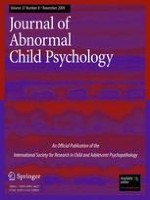01-11-2009
Re-examining the Epidemiology of Sensory Regulation Dysfunction and Comorbid Psychopathology
Gepubliceerd in: Research on Child and Adolescent Psychopathology | Uitgave 8/2009
Log in om toegang te krijgenAbstract
The aims of this study were threefold: (1) to compare prevalence of sensory regulation dysfunction based on previously established criteria to rates established with a more representative community sample of 796 4-year-olds; (2) to examine ethnic/racial and gender differences in prevalence according to the different criteria; and (3) to examine the co-occurrence of sensory regulation dysfunction and preschool psychiatric disorders. Prevalence rates ranged from 3.4% (current criteria) to 15.6% (previous criteria). In contrast to previous studies with less representative samples, there were no significant ethnic or racial differences using the current criteria. Boys were more likely to have sensory regulation dysfunction than girls according to all criteria. Depending upon impairment criteria used, 33–63% of children meeting criteria for sensory dysregulation also had a psychiatric disorder; 37–67% had only a sensory dysregulation disorder, indicating that sensory regulation dysfunction exists independent of psychiatric disorder, and is also a significant risk factor for disorder.
